Introduction
If you haven’t tried zongzi (粽子), you’ve been missing out. These famous Chinese sticky rice dumplings are as comforting and rewarding as Chinese food gets. Zongzi comes in many versions, but at heart, it is a pocket of fist-sized sticky rice with tasty fillings wrapped in gorgeous bamboo leaves.

Jump To
- Introduction
- Cultural significance of eating Zongzi
- Seasonal significance and regional variations
- Ingredients for Zongzi
- Cooking instructions and wrapping technique
- Pro tips for making the perfect zongzi
- Serving, store, and reheating
- Conclusion
- Zongzi (Sticky Rice Dumpling, Making 2 Easy Ways)
- YOU AY ALSO LIKE
Unwrapping a tasty zongzi is a cherished childhood memory of mine. Making zongzi is not particularly hard either, and while zongzi can vary in size, shape, and fillings, this recipe is one of my favorites. Here’s how to make zongzi at home. Read on!
Cultural significance of eating Zongzi
Eating zongzi holds significant cultural importance, especially in Chinese traditions. Such as:
- Dragon Boat Festival (Duanwu Festival 端午节): Zongzi and dragon boat races are strongly associated with the Dragon Boat Festival, also known as Duanwu Festival, which is celebrated on the 5th day of the 5th lunar month in the Chinese calendar. According to the legend, Qu Yuan(who lived during the Warring States period of ancient China), in despair over the state of his country, drowned himself in the Miluo River. The festival commemorates the life and death of Qu Yuan, the poet Qu Yuan and statesman. Eating zongzi during this festival is a way to pay tribute to Qu Yuan and ward off evil spirits, but I like to have them year-round.:)
- Symbol of Protection: The local people, who admired and respected him, threw rice dumplings into the river to prevent fish from eating Qu Yuan's body after he drowned himself in protest against political corruption.
- Ancestral and Family Connection: Many families in China gather together to make and enjoy Zongzi as a family activity. It serves as a way to honor ancestors and strengthen family bonds, as the tradition of making zongzi is often passed down through generations.
- Cultural Heritage: On the 5th day of the 5th month each year, Zongzi is deeply rooted in Chinese culinary traditions and represents the rich cultural heritage of the country. The preparation and consumption of zongzi during traditional festivals help preserve and pass on cultural practices and values to future generations.
Seasonal significance and regional variations
Seasonal Significance: The Dragon Boat Festival takes place during the summer season when diseases and pests are prevalent. You can use the ingredients such as bamboo leaves and certain herbs, to possess natural antibacterial properties.
Regional Variations: Zongzi holds significance with different regions of China, having their own unique recipes and methods of preparation. For example, the northern region of China tends to prefer a sweeter taste, while the southern region leans towards a more savory and salty flavor.
Ingredients for Zongzi
Sticky Rice (glutinous or sweet rice): You will always need glutinous rice for making zongzi. Sticky rice is a short-grain rice that becomes soft, sticky, and slightly chewy when cooked. You can easily get it from Asian grocery stores.
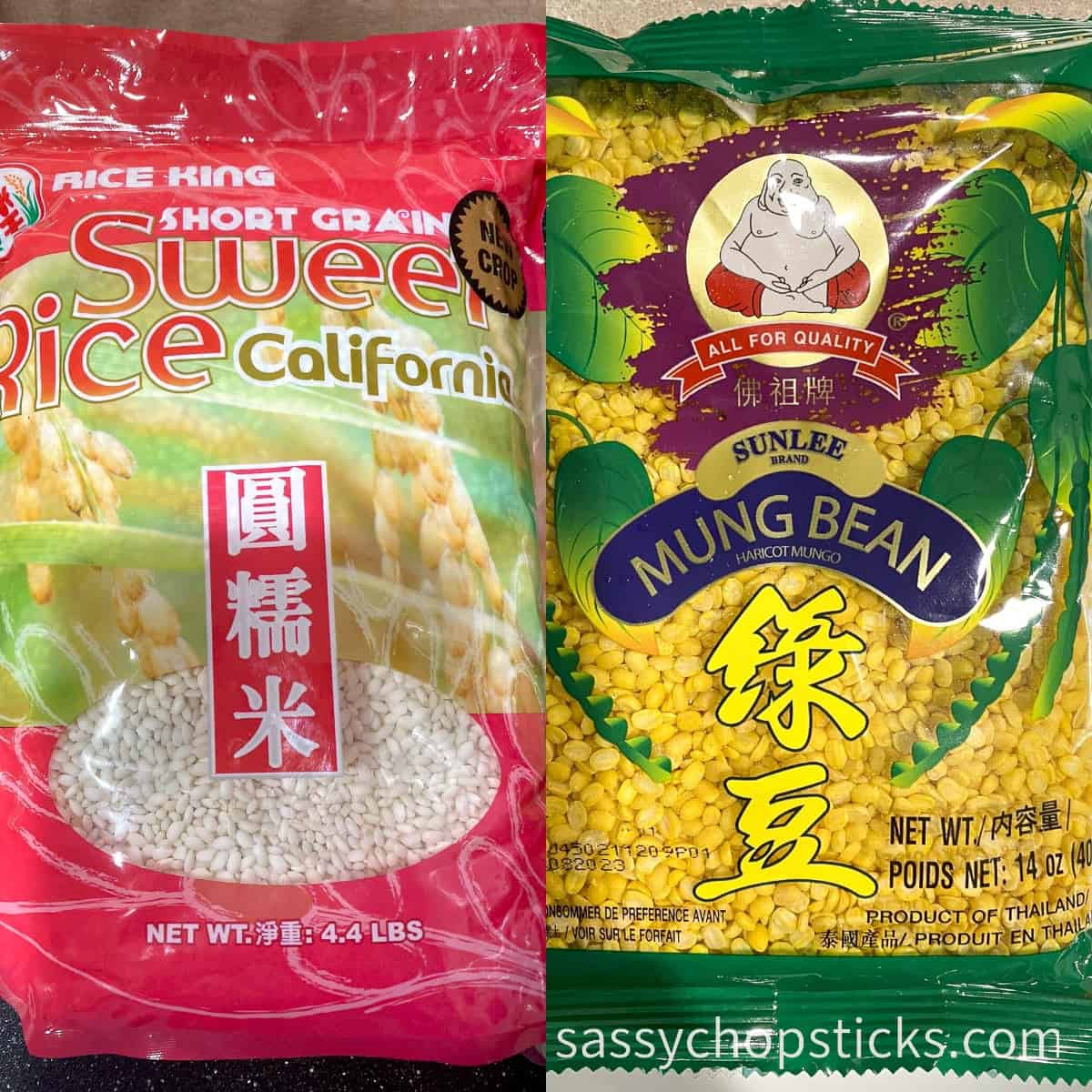
Bamboo Leaves: Bamboo leaves are a major component, as they keep the rice dumpling moist and tightly tucked. Some zongzi versions use maize or banana leaves instead. You can use bamboo leaves to wrap the sticky rice and create the signature pyramid or rectangular shape of zongzi. The leaves impart a unique fragrance and flavor to the rice during the cooking process.
Some common vegetarian/vegan fillings include:

- Mung beans: They add extra flavor and texture to the filling.
- Mushrooms: I use Shiitake mushrooms for their earthy flavor and meaty texture.
- Raw peanuts: Often added for extra crunch and texture.
- Red Bean Paste: Sweet and smooth paste made from cooked red beans. Sweet and smooth paste made from cooked red beans.
- Lotus Seed Paste: Sweet paste made from lotus seeds, commonly used in traditional Chinese desserts.
- Dried red dates(Chinese dates): They have a natural sweetness that adds a fruity taste to zongzi without the need for excessive sugar.
- Medjool dates: They have a sweet taste and soft, chewy texture. They usually are bigger than the regular red dates.
- Raisins: They are also a natural sweetener, like red dates, to enhance the overall taste of filling.
- Pinto beans and black-eye peas: They provide a unique and desirable texture and bring a creamy chewiness to the filling.
- Roasted chestnuts: Roasted or boiled chestnuts offer a nutty and sweet taste.

Meat filling options:
- Marinated chicken pieces: Typically marinated with soy sauce, dark soy sauce, Shaoxing wine, sugar, salt, and black pepper.
- Chinese Sausage (Lap Cheong): Adds a rich and savory flavor to the filling.
Other variations of fillings options
Salted duck egg yolk: Provides a creamy and salty element to the filling.
Dried shrimp: Adds a hint of umami and seafood flavor; dried scallops or oysters can also be added for extra depth of flavor.
Lotus seed paste: Sweet paste made from lotus seeds, commonly used in traditional Chinese desserts.
Mixed vegetables: You can add Carrots, peas, corn, and other vegetables for a colorful and nutritious filling.
Tofu: Dried or tofu skin (bean curd sheets) provides a protein-rich option.
Marinated Pork: You can marinate pork belly or lean pork in the same sauce mixture with marinated chicken pieces.
Cooking instructions and wrapping technique
Here are the step-by-step instructions:
Starting by soak the sticky rice: Rinse the sticky rice under cold water until the water runs clear. Place the rice in a large bowl and cover it with water. Let the rice soak for at least 4 hours or overnight, ensuring it is fully submerged.
Prepare the bamboo leaves: Rinse the bamboo leaves thoroughly to remove dirt or debris. Place the leaves in a large pot and allow them to soak for about 30 minutes to soften them.
Season the sticky rice (optional): Drain the soaked sticky rice and transfer it to a mixing bowl. Season the rice with soy sauce or any desired seasonings, and mix well. This step is optional and you can be skip it if you prefer plain sticky rice. This is what I did.
Wrapping the zongzi: There are two ways to wrap the zongzi. If you are making zongzi for the first time, try to use the second easier method to prevent failure.
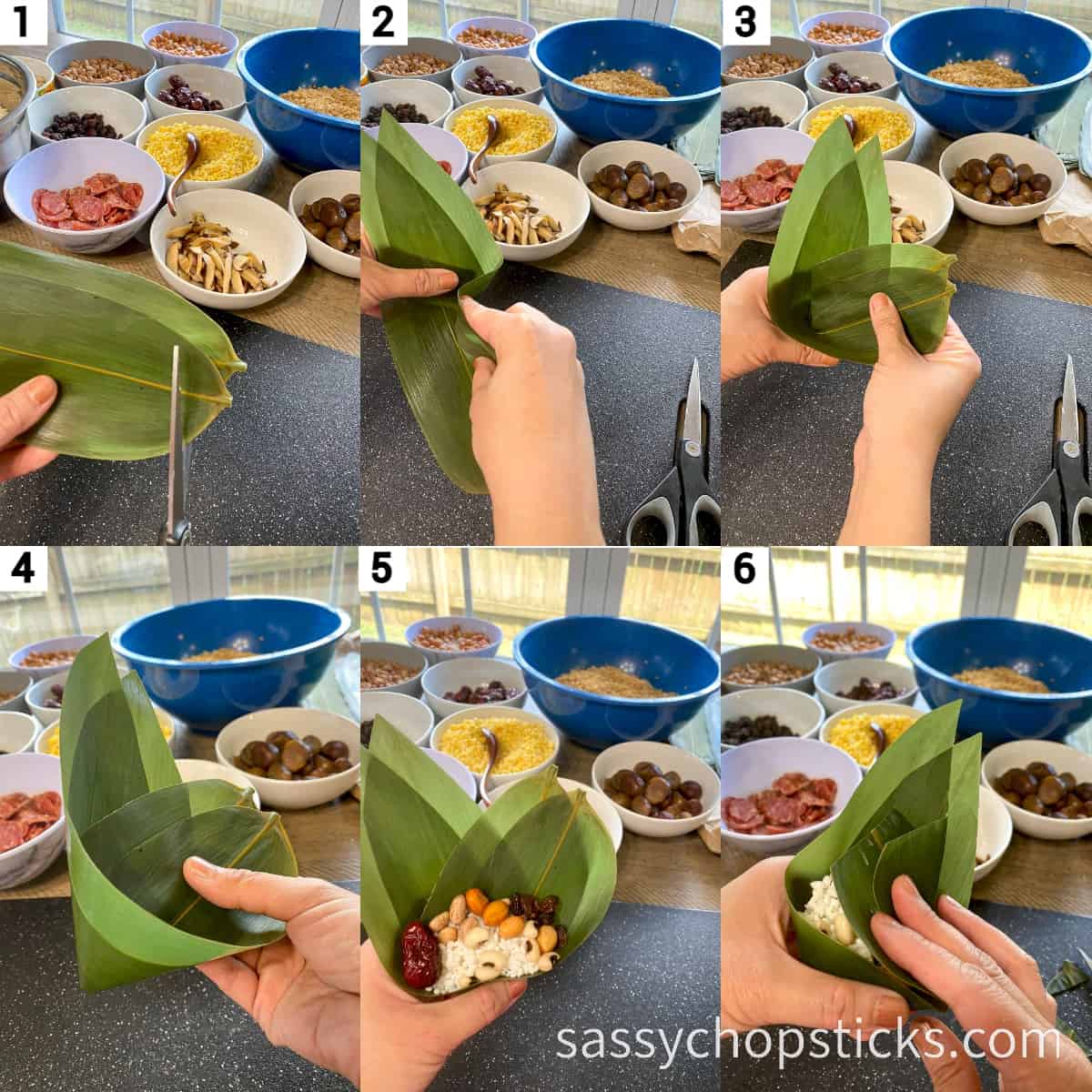
- Method 1 Triangle shape: Take two bamboo leaves and overlap them partially, creating a cone shape. Fill the cone with a spoonful of sticky rice, pressing it down gently. Add your fillings on top of the rice. Cover the fillings with another spoonful of sticky rice. Fold the bamboo leaves tightly to enclose the filling and form a pyramid or rectangular shape. Tie the zongzi securely with kitchen strings, ensuring it is tightly wrapped.
- Method 2 Square shape: Take two bamboo leaves and overlap them partially, creating a rectangle shape. Lay a spoonful of sticky rice in the center, pressing it down gently. Add your fillings on top of the rice. Fold the bamboo leaves tightly to enclose the filling and form a square shape. Tie the zongzi securely with kitchen strings, ensuring it is tightly wrapped.
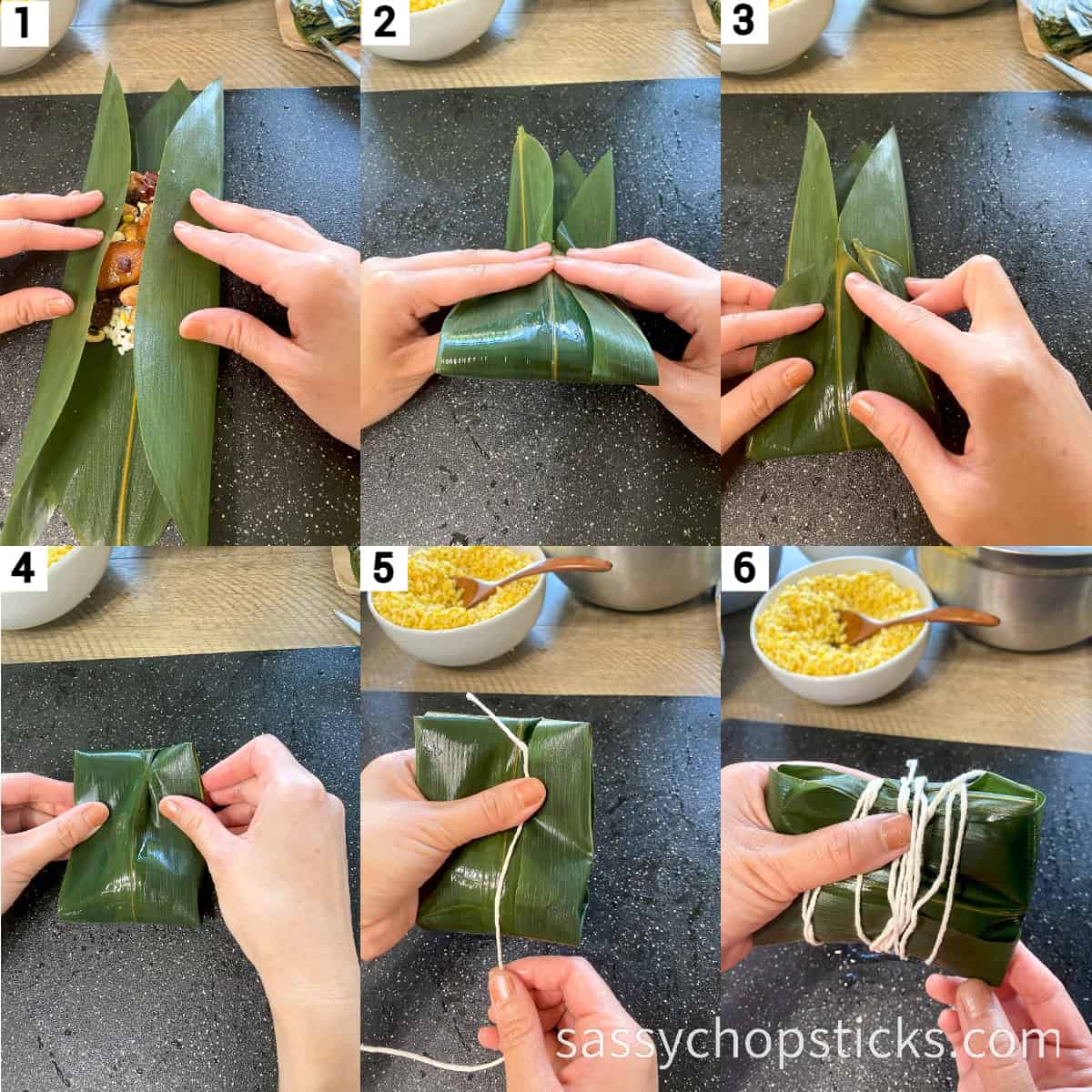
Cooking the zongzi:
The traditional and most common cooking methods are boiling and steaming, you can also use a pressure cooker. I used the boiling method in this recipe.

Prepare a large pot with water. Place the wrapped zongzi in the a big pot, making sure they are not stacked too tightly. Cover the pot with a lid and boil over medium-high heat for about 2 to 3 hours. Check the zongzi occasionally and add more water if needed to maintain the steam.
If you are steaming the zongzi, use a deep pot with a steaming rack with enough water or a steamer pot, and place the wrapped zongzi on the steaming rack . Steam the zongzi over medium-high heat for about 2 to 3 hours. Dont forget to check if the zongzi is cooked, carefully unwrap one zongzi and taste the sticky rice. It should be tender and fully cooked.

Carefully remove the steamed zongzi using tongs or a spatula. Allow them to rest in a pot of cool water for a few minutes before unwrapping.(optional) Serve and enjoy your homemade zongzi!
Remember, the cooking time may vary depending on the size of the zongzi and the heat intensity. You can adjust the fillings according to your preferences.
Pro tips for making the perfect zongzi
To make perfect zongzi, here are some key tips to keep in mind:
- Make sure that the sticky rice is properly soaked for at least 4 hours or overnight. This allows the rice to absorb enough water and achieve the desired texture when cooked.
- Choose fresh and high-quality bamboo leaves for wrapping the zongzi. Soak them in hot water to soften them and make them more pliable. I have to confess that the bamboo leaves I bought are a little smaller, so try to get bigger bamboo leaves, especially in width if you can, so you can wrap zongzi easier!
- Take time to wrap these sticky rice dumpling tightly and securely so that the filling and rice stay intact during cooking.
- Resting before unwrapping the cooked zongzi: Allow the steamed zongzi to rest for a few minutes before unwrapping them. This helps the flavors to settle and the rice to firm up slightly.

By following these tips, you'll increase your chances of making delicious and well-executed Zongzi. I know its easy to say than do it, be patient, and it takes some practice to fold zongzi. Don't be discouraged if it takes a few attempts to get it just right.
Serving, store, and reheating
- You can serve zongzi as is or paired with condiments. Beside honey, some alternative include soy sauce, toasted sesame seeds, chili sauce, or a combination of soy sauce and sesame oil. Feel free to drizzle the condiment over the zongzi or served on the side for dipping.
- You can make zongzi a convenient meals or packed lunch. Such as wrap them in plastic wrap or stored in airtight containers for easy transportation or consumption on the go.
- You can store these sticky rice dumplings for several days in the refrigerator. When properly stored in the freezer, they can last up to 3 months.
- If you have leftover zongzi, you can reheat them by steaming for a few minutes until warmed through. Alternatively, I have also tried unwrapping the zongzi and heating them in the microwave, which also works. I suggest starting with 30-second intervals and adjusting as needed.
- Freezing for Later: You can freeze the Zongzi after wrapping and cooked. Allow them to cool completely, then place them in freezer-safe containers or ziplock bags. When ready to eat, thaw them in the refrigerator overnight and reheat by steaming until heated through.

Conclusion
I hope you enjoyed this post. In fact, I am enjoying Zongzi while editing this post( I can't resist it, haha), and I hope you are enjoying yours as well! Lastly, I wish you have a wonderful Dragon Boat Festival day with family that is filled with joy! 🙂
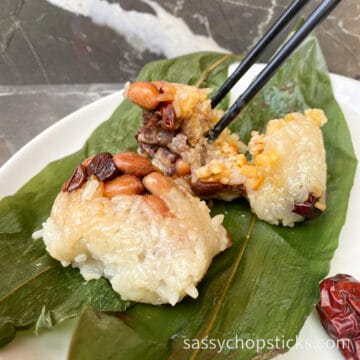
Zongzi (Sticky Rice Dumpling, Making 2 Easy Ways)
Equipment
Ingredients
- 5 cups sticky rice also called glutinous rice or sweet rice
- 50 bamboo wrapper
- 2 cups mung beans
- 2 cups red bean paste
- 6 tablespoons pinto beans
- 4 tablespoons black-eye peas
- 2 cups dried red dates
- 1 cup Medjool dates
- 5 mushroom sliced
- 4 Chinese sausages
- 2 cups diced marinated chicken pieces marinated with 2 tablespoons light soy sauce,½ tablespoon dark soy sauce,1 tablespoon Shaoxing wine, and a pinch of sugar, salt, black pepper
- 1 cup roasted chestnuts
- ½ cup red raisins
- 1 cup raw peanuts
- honey for serving
Instructions
- Soak the sticky rice: Rinse the sticky rice under cold water until the water runs clear. Place the rice in a large bowl and cover it with water. Let the rice soak for at least 4 hours or overnight, ensuring it is fully submerged.
- Prepare the bamboo leaves: Rinse the bamboo leaves thoroughly to remove dirt or debris. Place the leaves in a large pot and allow them to soak for about 30 minutes to soften them.
- Season the sticky rice (optional): Drain the soaked sticky rice and transfer it to a mixing bowl. Season the rice with soy sauce or any desired seasonings, and mix well. This step is optional and can be skipped if you prefer plain sticky rice. This is what I did.
- Wrapping the zongzi:Method 1 -Triangle shape: Take two bamboo leaves and overlap them partially, creating a cone shape. Fill the cone with a spoonful of sticky rice, pressing it down gently. Add your fillings on top of the rice. Cover the fillings with another spoonful of sticky rice, ensuring it is packed firmly. Fold the bamboo leaves tightly to enclose the filling and form a pyramid or rectangular shape. Tie the zongzi securely with kitchen strings, ensuring it is tightly wrapped.Method 2 -Square shape: Take two bamboo leaves and overlap them partially, creating a rectangle shape. Lay a spoonful of sticky rice in the center, pressing it down gently. Add your fillings on top of the rice. Fold the bamboo leaves tightly to enclose the filling and form a square shape. Tie the zongzi securely with kitchen strings, ensuring it is tightly wrapped.
- Cooking the zongzi: The traditional and most common cooking methods are boiling and steaming, you can also use a pressure cooker. I used the boiling method in this recipe. Prepare a large pot with water. Place the wrapped zongzi in the a big pot, making sure they are not stacked too tightly. Cover the pot with a lid and boil over medium-high heat for about 2 to 3 hours. Check the zongzi occasionally and add more water if needed to maintain the steam. If you are steaming the zongzi, use a deep pot with a steaming rack with enough water or a steamer pot, and place the wrapped zongzi on the steaming rack . Steam the zongzi over medium-high heat for about 2 to 3 hours. To check if the zongzi is cooked, carefully unwrap one zongzi and taste the sticky rice. It should be tender and fully cooked.
- Carefully remove the steamed zongzi using tongs or a spatula. Allow them to rest in a pot of cool water for a few minutes before unwrapping.(optional) Serve and enjoy your homemade zongzi!


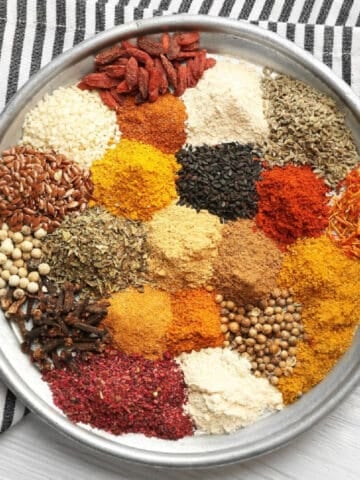
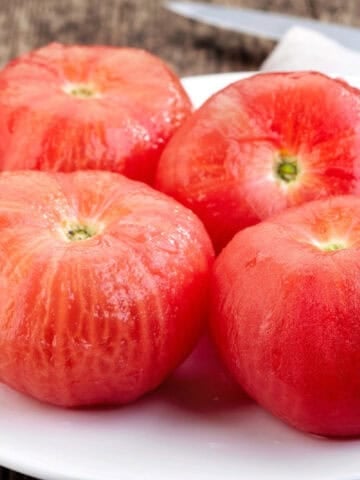

Leave a Reply